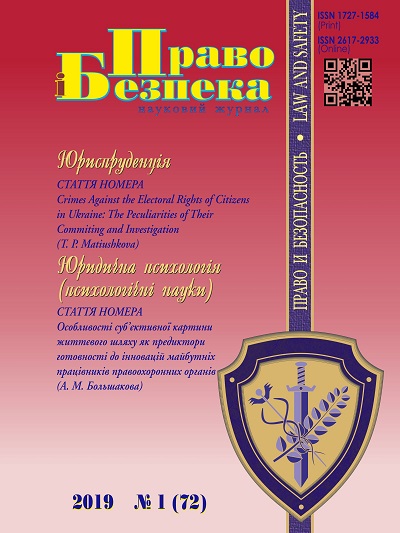Some Basic Aspects of Militia Activities in Ukrainian SSR in 1933
DOI:
https://doi.org/10.32631/pb.2019.1.03Keywords:
Ukraine, 1933, NKVS, militia, passport system, HolodomorAbstract
The authors’ objective was to study the main aspects of militia’s activities in 1933. This objective is specified in the following tasks: to highlight the work of militia regarding the introduction of passportization in Ukraine; to reveal certain aspects of its activity during the grain supplies in 1933. The authors of the article highlight for the first time the role of militia in carrying out grain supplies in 1933 in Ukraine. Materials on the implementation of passportization in the Republic have been supplemented through the prism of the tasks and activities of militia in this direction.
It has been noted that the system of registration and control of population in the cities of Ukrainian SSR was radically changed at the end of 1932. The exact time for the introduction of passportization was chosen not by chance – collectivization in Ukraine ended and the Holodomor began. The result of these processes was a massive flight of peasants from villages who tried to survive and escape from the Holodomor. The main feature of the new passport system was the fact that passports were issued only to those residents of cities, workers’ settlements, state-owned enterprises and new buildings who reached the age of 16 years. An absolute majority of villagers did not have the opportunity to get this document and therefore became attached to their places of residence.
Practical conduction of passportization of the population in Ukrainian SSR revealed an unfavorable demographic situation in the country and the presence of a large number of declassed persons who did not have a permanent job or committed crimes. The introduction of the passport system positively affected the organization of combating crime and ensuring state security, the registration of receptees was established. At the same time, passportization was accompanied by numerous repressions of judicial and extrajudicial nature. Militia being a part of the State Political Administration took an active part in the grain supplies campaign of 1932-1933, which led to the Holodomor. That activity had negative and repressive nature. Officers of militia also investigated the cases involving cannibalism.
Downloads
References
Tarasov A.Yu., 2005. The Passport System and the Passport Regime in the Soviet State in the 30-s of XX Century [Pasportnaya sistema i pasportnyi rezhim v Sovetskom gosudarstve v 30-ye gg. XX veka]. Abstract of Ph.D. dissertation. Moscow University of the Ministry of Internal Affairs of the Russian Federation.
Kirichenko Yu.N., 2010. Organization and Legal Basis for the Functioning of the Passport Service of the Soviet Militia in the Prewar Period and in the Years of the Great Patriotic War (1932-1945) [Organizatsionno-pravovye osnovy funktsionirovaniya pasportnoi sluzhby sovetskoi militsii v predvoennyi period i v gody Velikoi Otechestvennoi voiny (1932-1945 gg.)]. Abstract of Ph.D. dissertation. The Academy of Management of the Interior Ministry of Russia.
On the Passport System and the Unloading of Cities from Unnecessary Elements [O pasportnoi sisteme i razgruzke gorodov ot lishnikh elementov]. Archives of the President of the Russian Federation Herald [Vestnik Arkhiva Prezidenta Rossiiskoi Federatsii], 1997, No. 6, pp. 101-121.
Khmelnitskii D., 2018. Stalin’s passport [Stalinskii pasport]. [online] Gefter. Available at http://gefter.ru/archive/25308 [Accessed 4 February 2019].
Popov V., 1996. Passport System of Soviet Serfdom [Pasportnaya sistema sovetskogo krepostnichestva]. Novyj mir – New world, [online], No. 6. Available at http://magazines.russ.ru/novyi_mi/1996/6/popov.html [Accessed 4 February 2019].
Central State Archives of Public Associations of Ukraine, collection 1, description 20, file 6394, leafs 2-10.
Vronska T.V. and Kulchytskyi S.V., 2011. Passporting of the Population [Pasportyzatsiia naselennia]. In: Smolii V.A. et al. (eds). Encyclopedia of the history of Ukraine [Entsiklopediia istorii Ukrainy]: in 10 vols. Vol. 8. Kyiv: Naukova dumka. Pp. 83-84.
Verbenskyi M.H., Yarmysh O.N., Protsenko T.O. et. al., 2015. Ministry of Internal Affairs of Ukraine: Events, Leaders, Documents and Materials (1917-2017) [Ministerstvo vnutrishnikh sprav Ukrainy: podii, kerivnyky, dokumenty ta materialy (1917-2017 rr.)]: in 6 vols. Vol. 4. Kyiv. Pp. 248-249. (Ed.: Avakov A.B.).
Grechenko V.А. and Klochko A.M., 2017. Crime in the Ukrainian Socialist Soviet Republic and Combating It in the First Half of 1930s [Zlochynnist v USRR ta protydiia yii u pershii polovyni 1930-kh rokiv]. Pravo bezpeka, No. 4, pp. 88-94.
Kulchytskyi S.V., 2006. Famine, Holodomor 1932-33 [Holod, holodomor 1932-33. In: Encyclopedia of Modern Ukraine [Entsiklopedia suchasnoi Ukrainy]: in 20 vols. Vol. 6. Kyiv: Instytut entsyklopedychnykh doslidzhen NAN Ukrainy. P. 79.
About the Struggle and the Next Tasks of the City Militia [Pro borotbu ta cherhovi zavdannia miskoi militsii], 1933. Militiaman of Kremenchuk [Militsioner Kremenchuchchyny], November 11.
Shapoval Yu.I. and Zolotarov V.A., 2002. Vsevolod Balytskyi. Person, Time, Environment [Vsevolod Balytskyi. Osoba, chas, otochennia]. Kyiv: Stylos.
Central State Archives of Public Associations of Ukraine, collection 1, description 1, file 2189, leafs 76-78.



